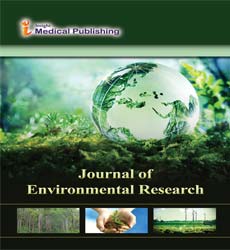The effectiveness of chemical oxidation in remediating hot and saline groundwater impacted with hydrocarbons
Joint Event on 4th International Conference on Pollution Control & Sustainable Environment & 6th Edition of International Conference on Water Pollution & Sewage Management
July 26-27, 2018 Rome, Italy
Mansor Kashir and Rick McGregor
Saudi Aramco, Saudi Arabia InSitu Remediation Services Ltd., Canada
ScientificTracks Abstracts: J Environ Res
Abstract
A series of laboratory microcosm experiments and a field-pilot test was performed to evaluate the potential for the in situ chemical oxidation of aromatic hydrocarbons and methyl tertiary butyl ether (MTBE), in saline, high temperature (greater than 30) groundwater. Groundwater samples from a site in Saudi Arabia were amended in the laboratory portion of the study with the chemical oxidants persulfate, percarbonate and stabilized hydrogen peroxide to evaluate the changes in select hydrocarbons and MTBE concentrations with time. Almost complete degradation of the aromatic hydrocarbons, naphthalene and trimethylbenzene was found in the groundwater samples amended with persulfate and stabilized hydrogen peroxide whereas the percarbonate-amended samples showed little to no degradation of the target hydrocarbon compounds in the laboratory. Isotopic analyses of the persulfate-amended samples suggested that C-isotope fractionation for xylenes occurred after approximately 30% reduction in concentration with a decline in the δ13C values of xylenes of about 1%. Based on the laboratory results, pilot-scale testing at a Saudi Arabian field site was carried out to verify the persulfate laboratory results. Results obtained from the pilot test indicated that all the target compounds decreased substantially with time. pH of the groundwater remained neutral following injections whereas oxidation-reduction potential remained anaerobic throughout the injection zone with time. Nitrate concentrations decreased within the injection zone suggesting that the nitrate may be consumed by denitrification reactions while sulfate concentrations increased as expected within the reactive zone suggesting that the persulfate was being reduced to sulfate. Overall, the injection of the oxidant persulfate was shown to be an effective approach to treating dissolved aromatic and associated hydrocarbons within the groundwater. The generation of sulfate as a byproduct was an added benefit as the sulfate could be utilized by sulfate-reducing bacteria (SRBs) presents within the subsurface to further biodegrade any remaining hydrocarbons. The results of the pilot-study using stabilized hydrogen peroxide as an oxidant suggested that the hydrogen peroxide was not stabilized by citric acid but instead the citric acid enhanced the oxidation of the target compounds including the oxidation of BTEX and MTBE. It appears that the citric acid may be chelating natural metal activators, such as ferric iron, and enhancing their activation function. Analysis of the BTEX compounds indicated a degradation percent of greater than 99% over the course of the study whereas MTBE was degraded by greater than 50%. Analysis of the TBA prior to and post injection suggested that TBA was not generated and in most cases TBA was degraded by greater than 75% during the pilot test. CSIA analysis indicated the 13C within the MTBE and benzene was enriched during the oxidation process. Bacterial analysis showed a dramatic change in the bacteria community makeup with aerobic bacteria responding quickly to the addition of stabilized hydrogen peroxide. Recent Publications 1. Mansor Kashir, et al. (2015) Chemical oxidation of high saline, high temperature groundwater impacted by hydrocarbons. Remediation Journal USA 25(2):55–70. 2. Mansour Kashir, et al. (2014) Aerobic biodegradation of hydrocarbons in high temperatures and saline groundwater. Remediation Journal USA 24(2):77–90. 3. Mansor Kashir, et al. (2009) A kinetic model for the remediation of hydrocarbon impacted soils using low temperature oxidation. Journal of ASCE Practice Periodical for Hazardous Toxic and Radioactive Waste Management 11(4):259- 267. 4. Mansor Kashir, et al. (2007) A numerical model simulating the remediation of hydrocarbon impacted soils using low temperature oxidation. Journal of Environmental Modeling and Assessment 13(2):265-274. 5. Mansor Kashir and Yanful E (2001) Hydraulic conductivity of bentonite permeated with acid mine drainage. Canadian Geotechnical Journal Canada 38(5):1034-1048.
Biography
Mansor Kashir is an Engineering Consultant in the Department of Environmental Protection, Saudi Aramco Oil Company, Saudi Arabia. He completed his BASc in Civil Engineering at University of Tripoli, Libya in 1984; MASc in Geotechnical Engineering at University of Waterloo, Canada in 1990 and; PhD in Geo-Environmental Engineering from University of Western Ontario, Canada in 1998. He is currently managing a number of site investigations and groundwater remedial studies at Saudi Aramco sites; including the use of mechanical, biological, and chemical treatment to remediate contaminated groundwater. Other interests and tasks include developing best environmental protection practices in the area of unconventional gas at Saudi Arabia, defining and treating credible corporate risks that could result from industrial incidents, their treatments and tools of monitoring of these risks.
E-mail: mansor.kashir@aramco.com
Google Scholar citation report
Citations : 65
Journal of Environmental Research received 65 citations as per Google Scholar report
Abstracted/Indexed in
- Google Scholar
- International Committee of Medical Journal Editors (ICMJE)
Open Access Journals
- Aquaculture & Veterinary Science
- Chemistry & Chemical Sciences
- Clinical Sciences
- Engineering
- General Science
- Genetics & Molecular Biology
- Health Care & Nursing
- Immunology & Microbiology
- Materials Science
- Mathematics & Physics
- Medical Sciences
- Neurology & Psychiatry
- Oncology & Cancer Science
- Pharmaceutical Sciences

